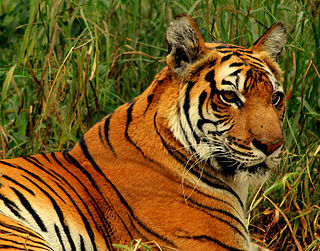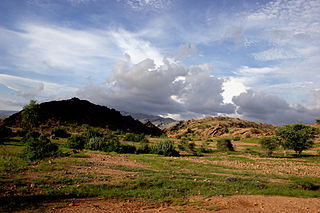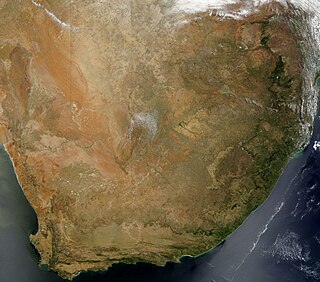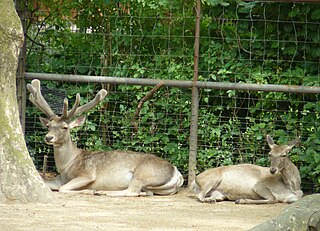Related Research Articles

The Jebel Akhdar is a heavily forested, fertile upland area in northeastern Libya. It is located in the modern shabiyahs or districts of Derna, Jabal al Akhdar, and Marj.

The Oakland Zoo is a zoo located in the Grass Valley neighborhood of Oakland, California, United States. Established on June 6, 1922, it is managed by the Conservation Society of California, a 501(c)(3) non-profit organization dedicated to the conservation of wildlife both locally and globally. The zoo is home to more than 850 native and exotic animals and is a member of the Association of Zoos and Aquariums (AZA).

India is the world's 8th most biodiverse region with a 0.46 BioD score on diversity index, 102,718 species of fauna and 23.39% of the nation's geographical area under forest and tree cover in 2020. India encompasses a wide range of biomes: desert, high mountains, highlands, tropical and temperate forests, swamplands, plains, grasslands, areas surrounding rivers, as well as island archipelago. Officially, three out of the 36 Biodiversity Hotspots in the world are present in India: the Himalayas, the Western Ghats, and the Indo-Burma region. To these may be added the Sundarbans and the Terrai-Duar Savannah grasslands for their unique foliage and animal species. These hotspots have numerous endemic species. Nearly 5% of India's total area is formally classified under protected areas.

The Living Desert Zoo and Gardens, formerly the Living Desert Museum, is a non-profit zoo and desert botanical garden located in Palm Desert, Riverside County, California, United States. The Living Desert is home to over 500 animals representing over 150 species and welcomes over 500,000 visitors annually. Situated in the Sonoran Desert of the Coachella Valley and Santa Rosa Mountains foothills near Palm Springs, California, The Living Desert is set on 1,200 acres, with 80 developed as zoo and gardens.

Leipzig Zoological Garden, or Leipzig Zoo is a zoo in Leipzig`s district Mitte, Germany. It was first opened on June 9, 1878. It was taken over by the city of Leipzig in 1920 after World War I and now covers about 27 hectares and contains approximately 850 species. By 2020, the zoo featured six different theme worlds, aiming at providing habitats appropriate for the species on display.

Mount Abu Wildlife Sanctuary is located in the Aravalli Range, one of the oldest mountain ranges in India. It was declared a wildlife sanctuary in 1980. The eco-sensitive zone around the sanctuary was notified on 11 Nov 2020.

The Marco Polo sheep is a subspecies of argali sheep, named after Marco Polo. Their habitat are the mountainous regions of Central Asia. Marco Polo sheep are distinguishable mostly by their large size and spiraling horns. Their conservation status is "near threatened" and efforts have been made to protect their numbers and keep them from being hunted. It has also been suggested that crossing them with domestic sheep could have agricultural benefits.
The wildlife of Iran include the fauna and flora of Iran.
Afghanistan has long been known for diverse wildlife. Many of the larger mammals in the country are categorized by the International Union for Conservation of Nature as globally threatened. These include the snow leopard, Marco Polo sheep, Siberian musk deer, markhor, urial, and the Asiatic black bear. Other species of interest are the ibex, the gray wolf, and the brown bear, striped hyenas, and numerous bird of prey species. Most of the Marco Polo sheep and ibex are being poached for food, whereas wolves, snow leopards and bears are being killed for damage prevention.

The wildlife of Armenia includes, in addition to plants, wild boars, porcupines, various lizards, snakes and numerous species of birds. Endangered species living in Armenia are the Caucasian bear, Caucasian bearded goat, the Armenian mouflon (sheep) and the leopard.

The wildlife of Jordan includes its flora and fauna and their natural habitats. Although much of the country is desert, it has several geographic regions, each with a diversity of plants and animals adapted to their own particular habitats. Fossil finds show that in Palaeolithic times, the region had Syrian brown bears, Asiatic lions, zebras, Asian elephants, and rhinoceroses, but these species are all now extinct in this region.

The wildlife of the Democratic Republic of the Congo includes its flora and fauna, comprising a large biodiversity in rainforests, seasonally flooded forests and grasslands.

Africa Alive! Zoological Reserve, formerly known as Africa Alive! and Suffolk Wildlife Park, is a zoo located in Kessingland, Suffolk, UK. It is situated off the A12 at Kessingland 2 miles (3 km) south of Lowestoft.

The Kirthar National Park is situated in the Kirthar Mountains in Jamshoro District in Sindh, Pakistan. It was established in 1974 and encompasses over 3,087 km2 (1,192 sq mi), making it the third largest national park in Pakistan. Wildlife in the park comprises leopard, striped hyena, Indian wolves, honey badger, urial, chinkara gazelles and rare Sindh ibex. Blackbuck are kept in enclosures for a reintroduction project.

The fauna of South Africa is diverse and largely typical of the ecosystems in Africa. South Africa is ranked sixth out of the world's 17 megadiverse countries. Many endemic species are unique to South Africa. The country is among the world leaders in conservation, but at the time wildlife is threatened by poaching and canned hunting.
This is a list of lists of notable fictional animals.

The wildlife of Mongolia consists of flora, fauna and funga found in the harsh habitats dictated by the diverse climatic conditions found throughout the country. In the north, there are salty marshes and fresh-water sources. The centre has desert steppes. In the south, there are semi deserts as well as the hot Gobi desert in the south, the fifth-largest desert in the world.
The wildlife of Lebanon refers to the flora and fauna of Lebanon, a country in Asia located at the eastern end of the Mediterranean Sea. The country has four main geographical areas: the coastal plain, Mount Lebanon, the Beqaa Valley and the Anti-Lebanon Mountains. The climate is Mediterranean, with the coastal regions experiencing hot, humid summers and cool, wet winters, and the elevated areas inland experiencing colder winters with snow that lingers on into the summer. The country offers a variety of habitats for wildlife, including mountains, valleys, marshes, coastal plains, salt marshes and sea coasts.

The wildlife of Turkmenistan is the flora and fauna of Turkmenistan, and the natural habitats in which they live. Turkmenistan is a country in Central Asia to the east of the Caspian Sea. Two thirds of the country is hot dry plains and desert, and the rest is more mountainous. Very little rain falls in summer and the chief precipitation occurs in the southern part of the country in the winter and spring. The Caspian coast has milder winters.
References
- ↑ Butler, R. A. (August 7, 2007), Adventures in conservation: protecting wildlife in Afghanistan: An interview with Dr. Alex Dehgan, Afghanistan Country Director for the Wildlife Conservation Society, Mongabay.com, archived from the original on August 19, 2007 Also here
- ↑ Manati, A.R.; Nogge, G. (2008). "Cheetahs in Afghanistan" (PDF). Cat News (49): 18.
- ↑ Nasr, Seyyed Hossein. "Ali". Encyclopædia Britannica Online. Encyclopædia Britannica, Inc. Archived from the original on October 18, 2007. Retrieved 2007-10-12.
- ↑ Tolonews (3 April 2017) Border Police Seize Six Lions At Spin Boldak Crossing Video (28s)